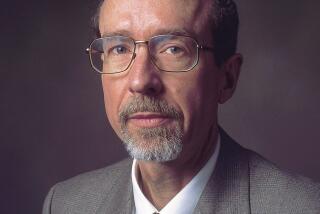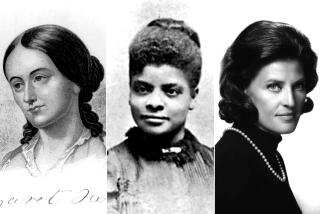His beat was his country
- Share via
David Halberstam, who died Monday in an auto accident, was one of the greatest among a pivotal generation of reporters and writers who reshaped the intellectual and stylistic landscape of American journalism in the 1960s and early 1970s.
Unlike his close friends Gay Talese, Joan Didion, John Gregory Dunne and Hunter Thompson, Halberstam seldom is linked to the tendency -- it never really was a movement -- that Tom Wolfe first called the New Journalism. The influence of his work from that era, however, remains decisive.
Because so many other writers have followed the path he first marked out, it’s difficult now to recall just how revolutionary his 1972 book “The Best and the Brightest” then seemed, with its synthesis of meticulous reporting, historical consciousness and narrative technique. Halberstam, moreover, brought these things to bear on a situation, Vietnam, which was then ongoing. It was the beginning of an entire genre of timely, narrative nonfiction books that we now take for granted, even as they enrich our public conversation.
Perhaps more important, Halberstam was the exemplar of a courageous intellectual approach to journalism that found its first clear public expression in a young combat correspondent’s refusal to buy the government line on Vietnam. They were there; they trusted the evidence of their eyes and refused to look away, no matter how much pressure successive American administrations and the local military commanders brought to bear.
As he said in a widely discussed Commentary piece in 1965, “No one becomes a reporter to make friends, but neither is it pleasant in a situation like the war in Vietnam to find yourself completely at odds with the views of the highest officials of your country. The pessimism of the Saigon press corps was of the most reluctant kind: many of us came to love Vietnam, we saw our friends dying all around us, and we would have liked nothing better than to believe the war was going well and that it would eventually be won. But it was impossible for us to believe those things without denying the evidence of our own senses.... And so we had no alternative but to report the truth.”
*
Forged in civil rights era
There’s a significant truth embedded in that passage. In the years that followed, critics would attempt to paint Halberstam and others fortunate enough to be described as his colleagues as practitioners of an “adversary journalism,” one rooted in one or another ideological hostility to American values and American institutions. Nothing could be further from the truth. In fact, while Halberstam won his Pulitzer Prize as a 30-year-old New York Times correspondent in Vietnam, I’ve always thought the experience that informed all of his subsequent work was his first full-time reporting job, covering the civil rights movement in Mississippi in the late 1950s. Like other idealistic young men and women who went south in those years, he believed segregation was wrong precisely because it was aberrational, a falling short of national ideals in which he believed deeply, a denial of the basic American goodness to people entitled to share in it. Here is how he later described the young journalists, like himself, covering the trial of the two white men charged with murdering Emmett Till, a young African American, for allegedly whistling at a white woman:
“The editors of the nation’s most important newspapers were men in their 50s, who by and large held traditional views of race but who, because of the Brown [school desegregation] decision, were going to pay more attention to the race issue. Their reporters were different. They were younger men in their 30s, often Southern by birth, more often than not men who had fought in World War II and who thought segregation odious. Moreover, they thought World War II was, among other things, about changing America and the South, where things like this could happen.
“They had long been ready to cover the South. Now they had their chance. The educational process had begun: The murder of Emmett Till and the trial of the two men accused of murdering him became the first great media event of the civil rights movement. The nation was ready; indeed, it wanted to read what happened.”
Those observations embody both the character and the arc of Halberstam’s subsequent project. As he often remarked in his many speeches around the country, he left the South with “a great faith in the common sense of the American people,” a renewed faith in American idealism and a courageously unshakable skepticism about the trustworthiness of those in authority to do right by either one.
In fact, most of the 21 books that Halberstam produced after he left Vietnam -- whether about war or sports, his other great love -- can be read as a continuing exploration of the American character, which the author believed best -- or, at least, most dramatically -- in conflict, whether on the battlefield or the playing field. (Others obviously shared that conviction, as 15 of his books were bestsellers.) Many, for example, regarded his book “Firehouse,” an account of the men of Ladder 35, Engine 40 from his own Manhattan neighborhood’s fire station, as one of the best and most humanizing of the books about 9/11.
*
The joy of legwork
We have an expression in journalism to describe the sort of lethargy that comes on reporters of a certain age: “losing your legs.” David Halberstam never lost his legs. He was 73 when he died, and he was on his way to an interview for his next book. He maintained not simply a faith in reporting as an honorable public service but an elemental joy in the experience itself.
At Columbia University not long ago, he spoke to students about what he took from those early years in Mississippi: “I learned how to work a story, how to talk to ordinary people, and what a joy doing legwork was. I learned the best question of all for any interview: ‘Who else should I see?’ To this day, the back cover of my notebooks is covered with lists of names of people to see. I learned that the more legwork you do, inevitably the better the writing seems because you have more details, more anecdotes, and more authority. And I learned that the great fun of journalism was talking to people, that it was where you kept learning. What a marvelous way to grow intellectually!”
In an interview now more than a decade old, Halberstam said of his career, “It’s been a wonderful life. Actually, when I think about my career I am sometimes stunned. I’m stunned by the richness of it. It gave me all the things I ever wanted. I loved being a reporter.” It showed, and few people who practice our vocation ever have done it quite so much credit.
*
More to Read
Sign up for our Book Club newsletter
Get the latest news, events and more from the Los Angeles Times Book Club, and help us get L.A. reading and talking.
You may occasionally receive promotional content from the Los Angeles Times.








